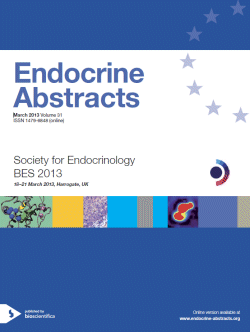Oral Communications
Reproduction, growth and development
ea0031oc3.1 | Reproduction, growth and development | SFEBES2013
Identification of very early sorting endosomes that spatially program gonadotrophin hormone receptor signalling
Jean-Alphonse Frederic , Bowersox Shanna , Chen Stanford , Beard Gemma , Puthenveedu Manojkumar , Hanyaloglu Aylin
ea0031oc3.2 | Reproduction, growth and development | SFEBES2013
Heterodimerisation of GNRH receptors modifies the LH-induced calcium signalling profile
Chen Stanford , Jonas Kim , Huhtaniemi Ilpo , Hanyaloglu Aylin
ea0031oc3.3 | Reproduction, growth and development | SFEBES2013
Regulation of G protein-coupling specificity via cis and trans activation of the LH/chorionic gonadotrophin receptor (LHCGR)
Jonas Kim , Muller Adolfo Rivero , Chou Yen Yin , Ji Tae , Hanyaloglu Aylin
ea0031oc3.4 | Reproduction, growth and development | SFEBES2013
Characterising changes in the in vivo male rodent brain using magnetic resonance spectroscopy
Rodie Martina , Welsh Michelle , Holmes William , Gallagher Lindsay , Mullin James , McMillan Martin , Macrae I Mhairi , Ahmed S Faisal
ea0031oc3.5 | Reproduction, growth and development | SFEBES2013
Effects of in utero exposure to acetaminophen (paracetamol) on steroidogenesis by the rat and human fetal testis
van den Driesche Sander , Dean Afshan , Anderson Richard , Sharpe Richard , Mitchell Rod
ea0031oc3.6 | Reproduction, growth and development | SFEBES2013
Follistatin-like 3 (FSTL3), a transforming growth factor β ligand inhibitor, is essential for placental development in mice
Robertson Rachel , Mahmood Waheed , McGonnell Imelda , Mukherjee Abir
ea0031oc3.7 | Reproduction, growth and development | SFEBES2013
Disruption of mesenchymal glucocorticoid signaling attenuates embryonic lung development and results in post natal lethality in mice
Hardy Rowan , Li Aiqing , Stoner Shihani , Tuckermann Jan , Seibel Markus , Zhou Hong
ea0031oc3.8 | Reproduction, growth and development | SFEBES2013
Adiponectin induces GSK3 kinase-mediated cross-tolerance to endotoxin in macrophages
Hand Laura , Ray David , Loudon Andrew , Bechtold David , Cooper Garth




